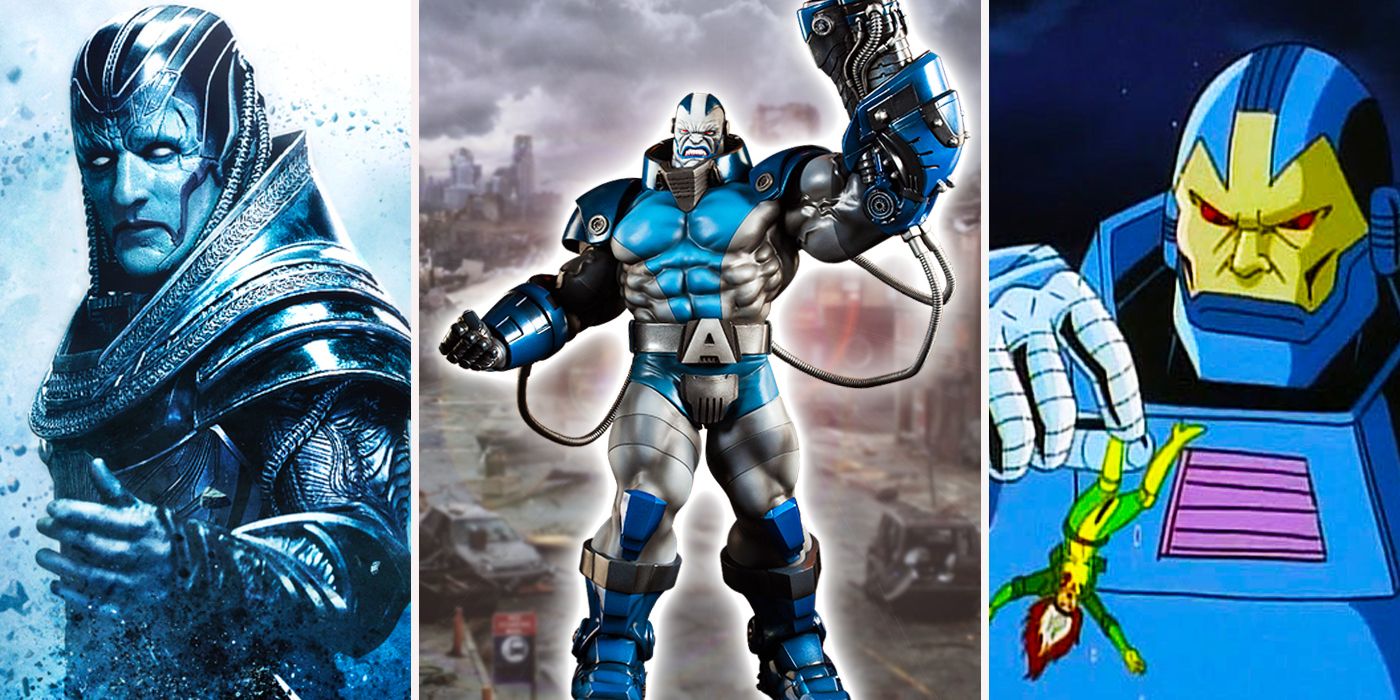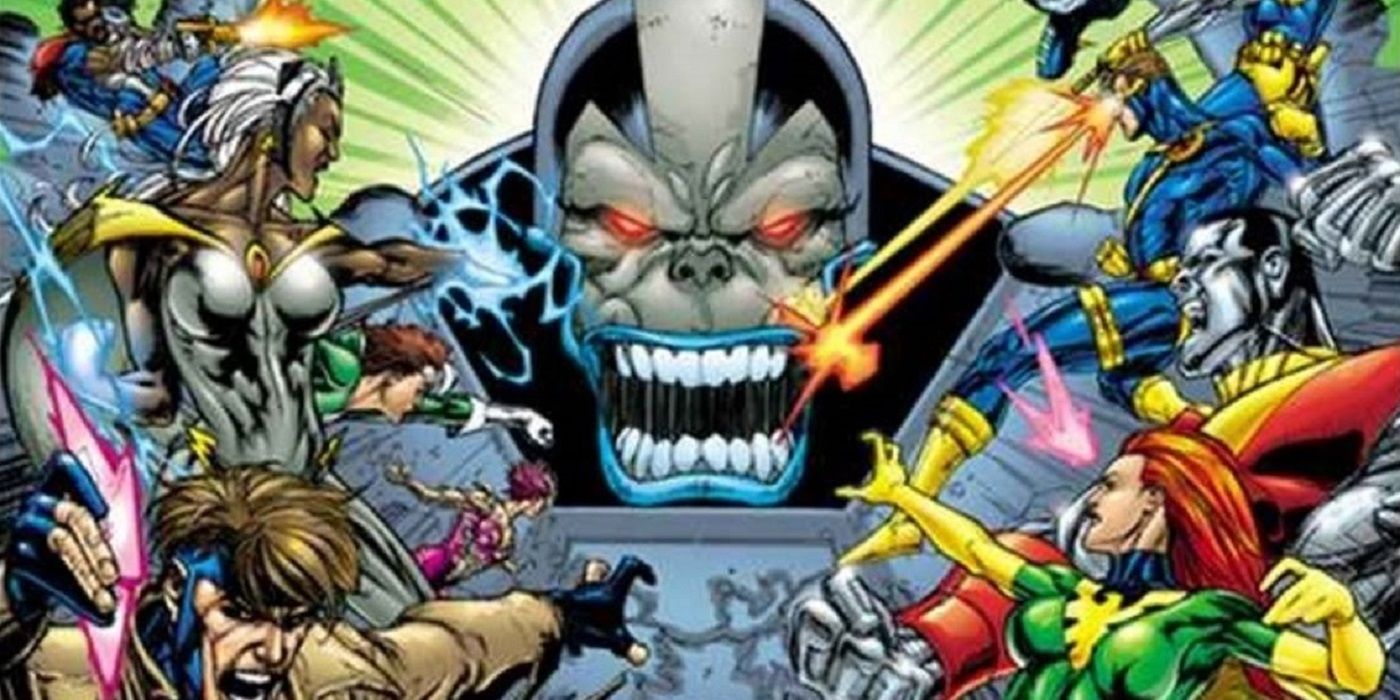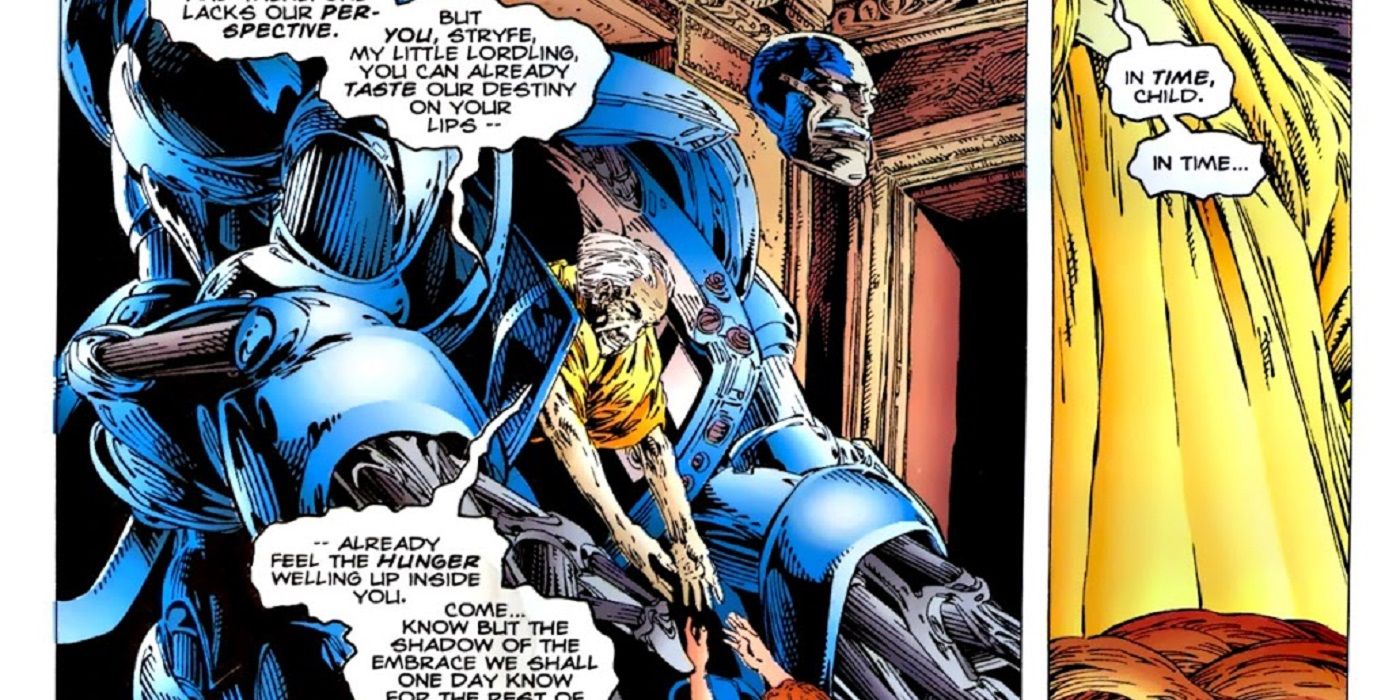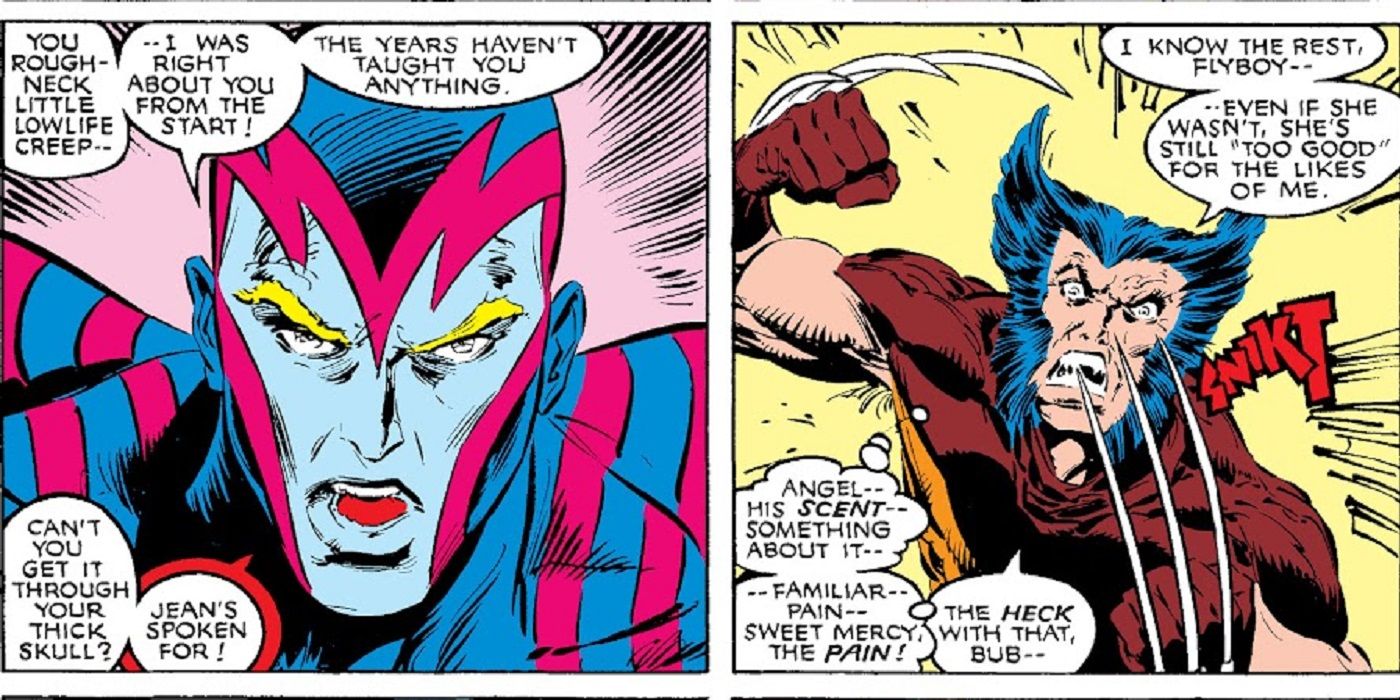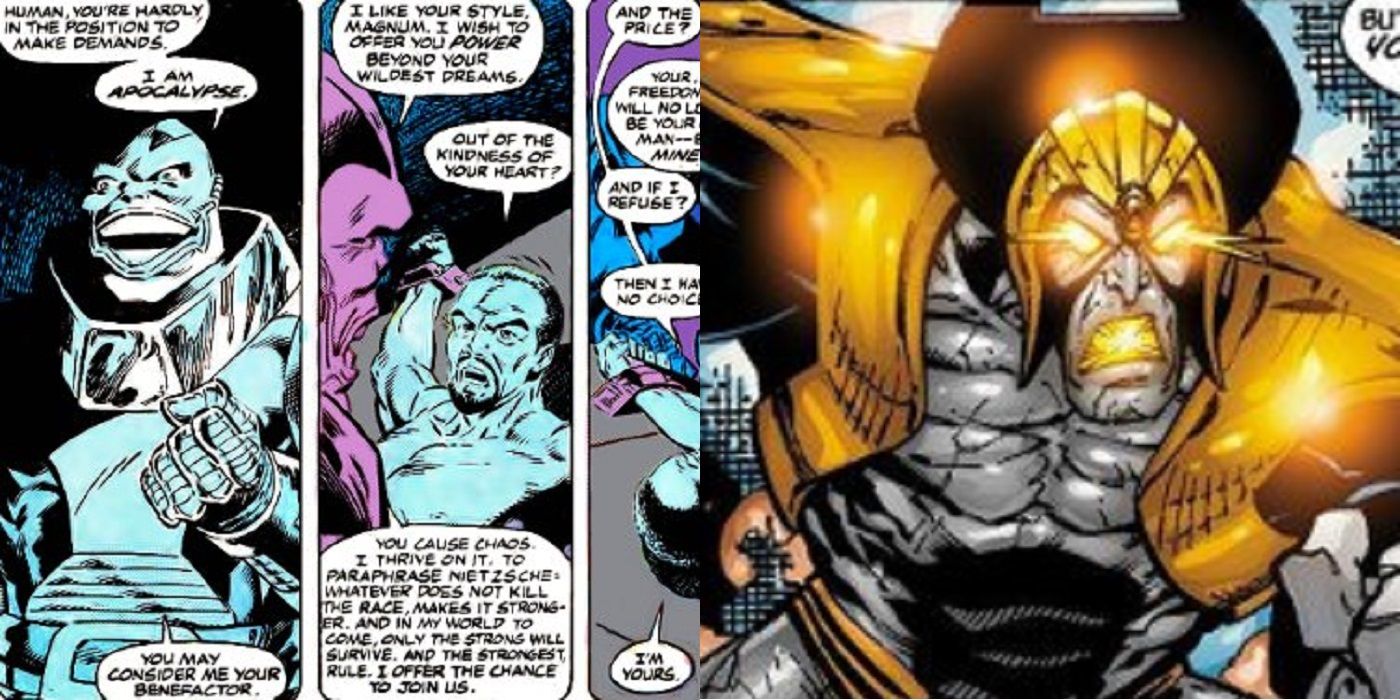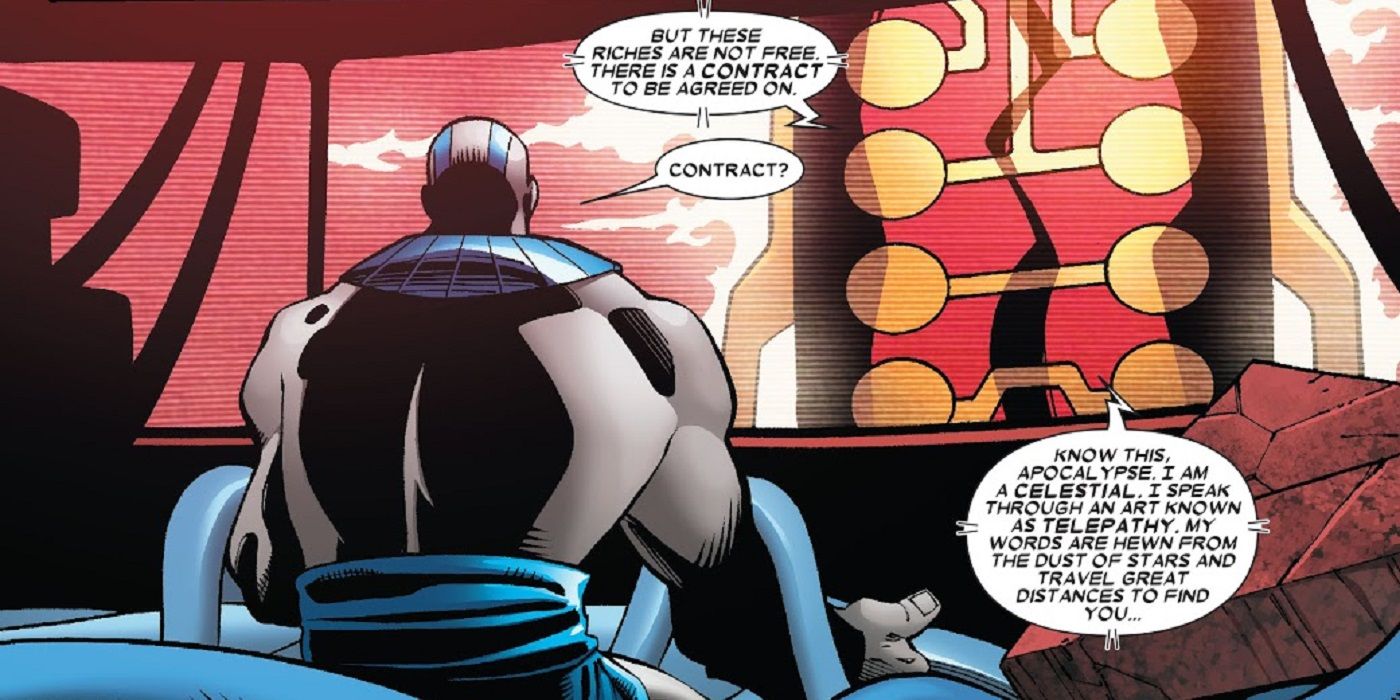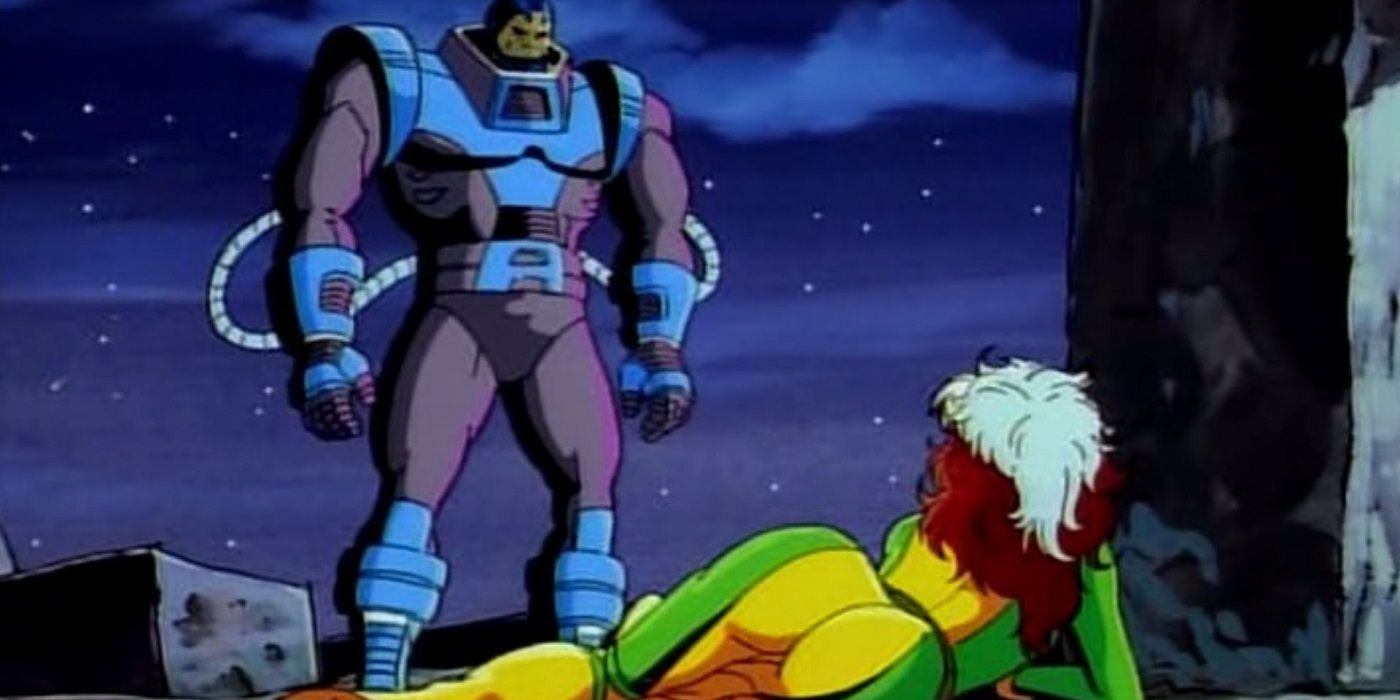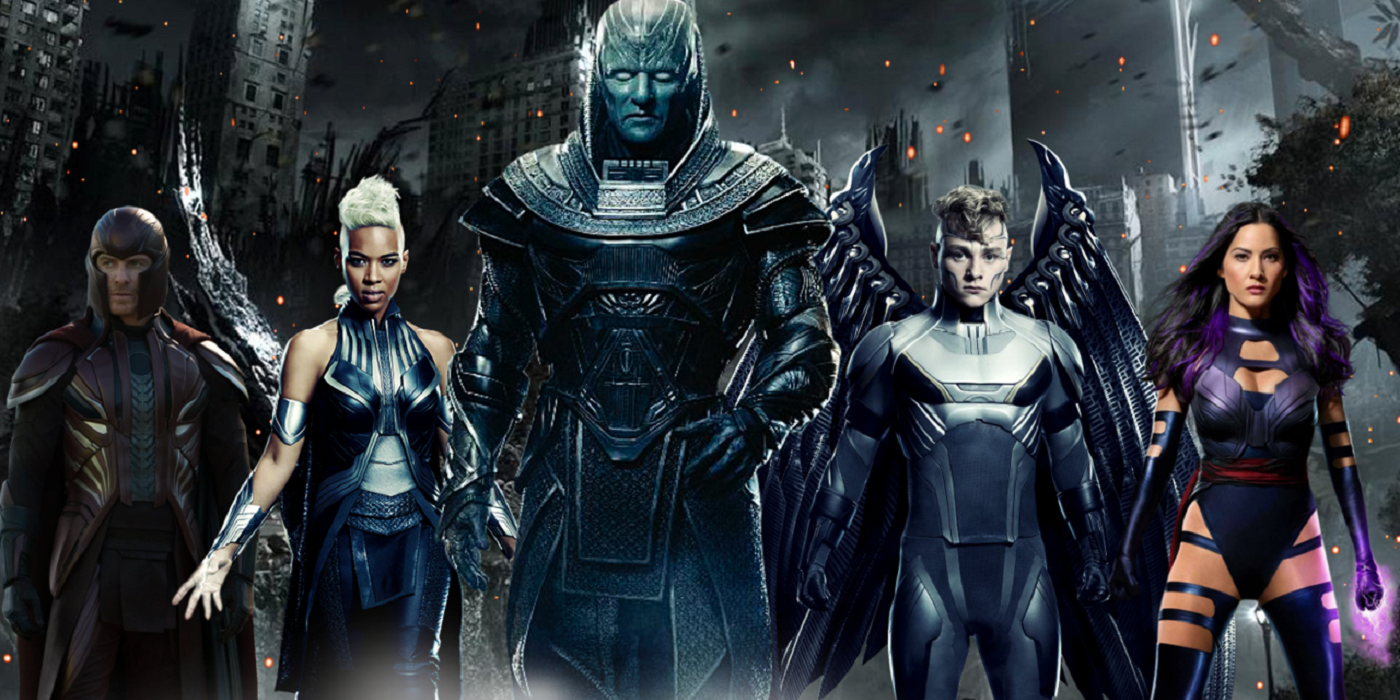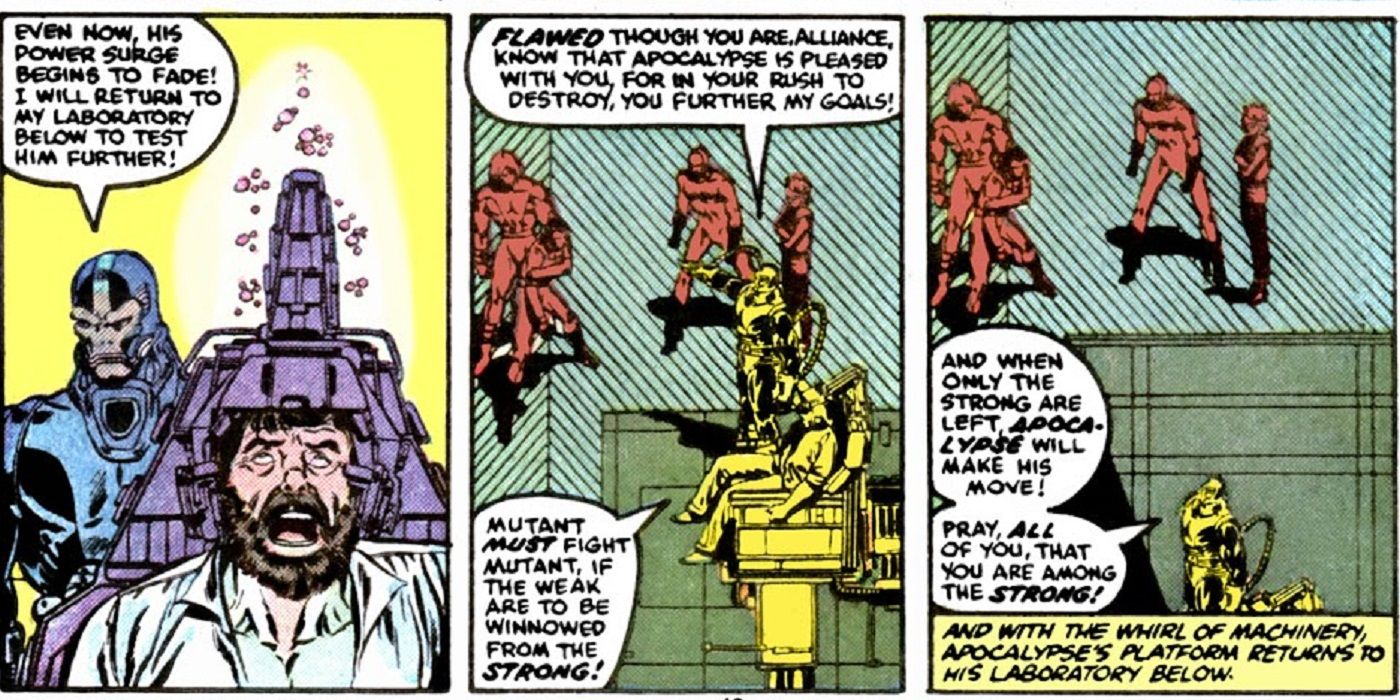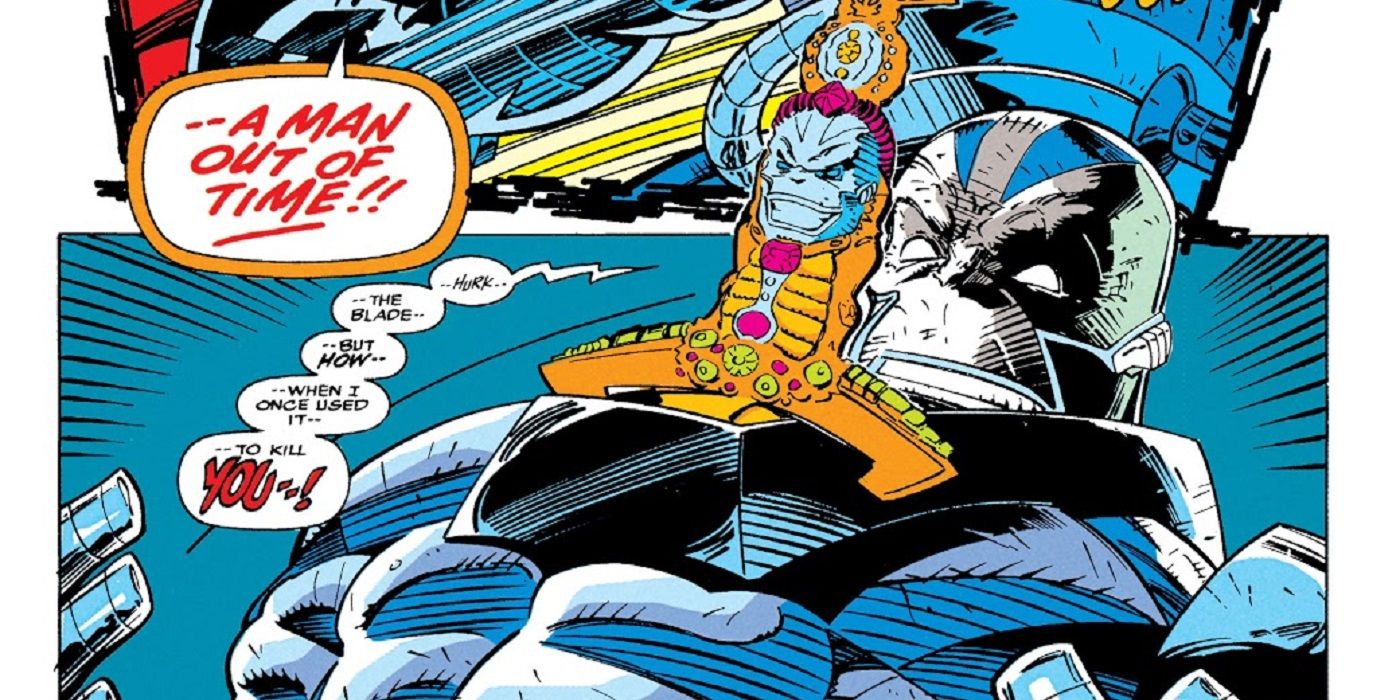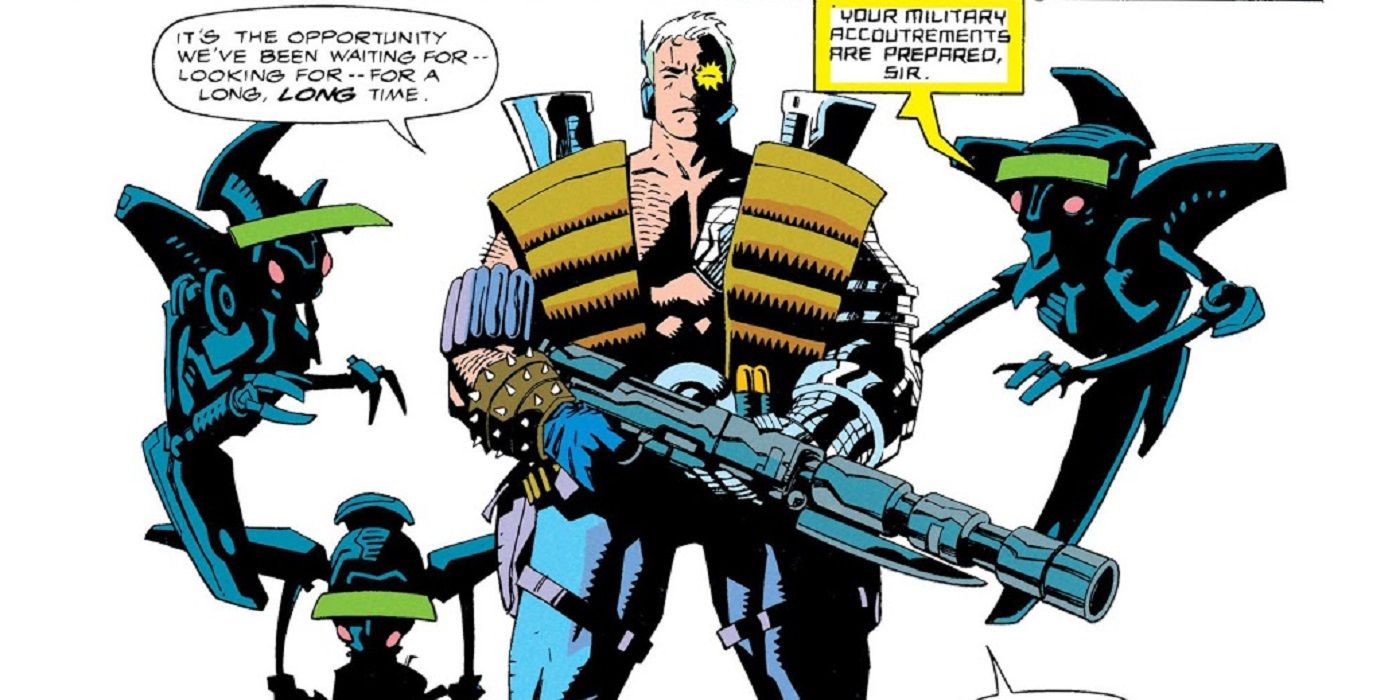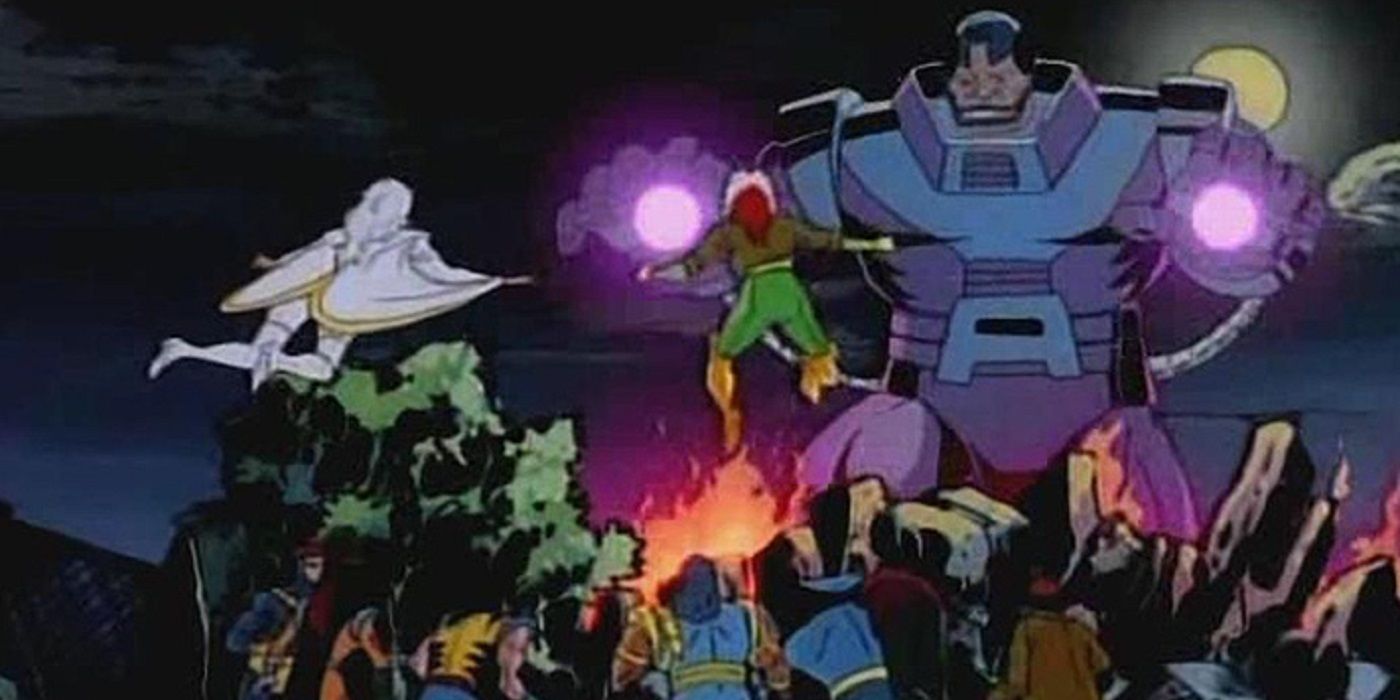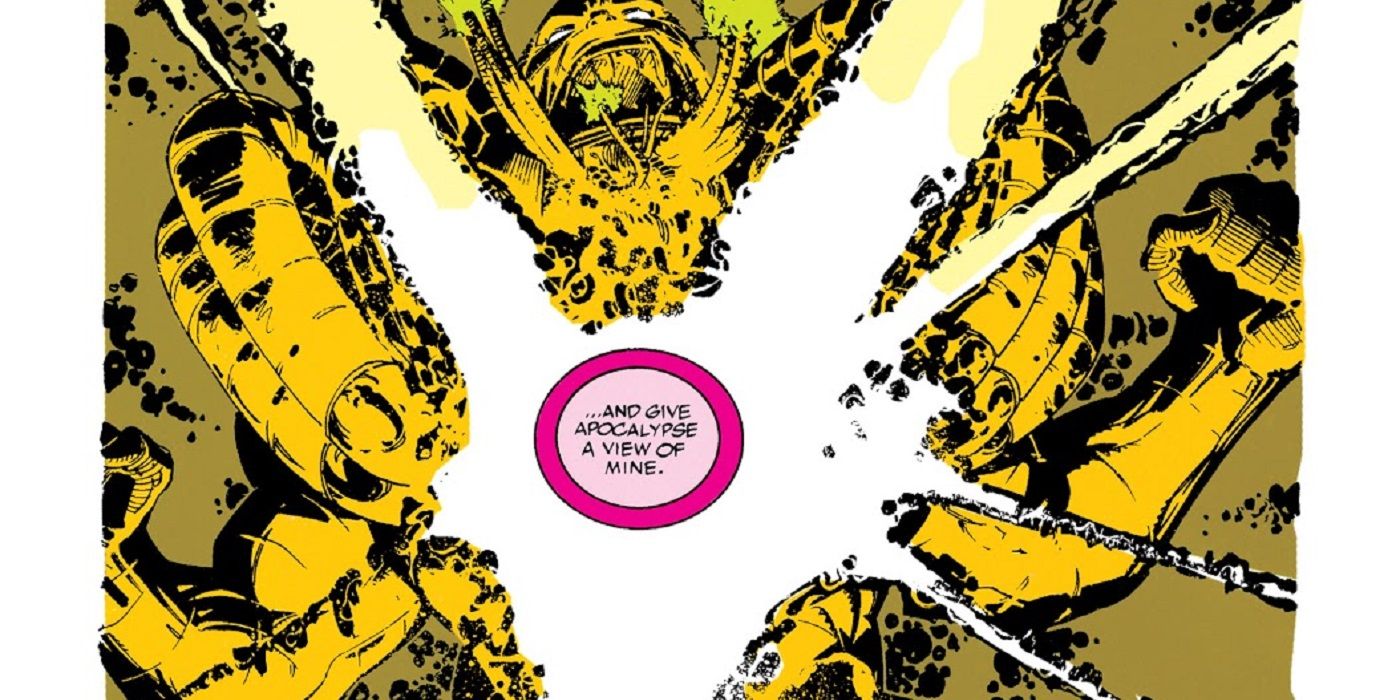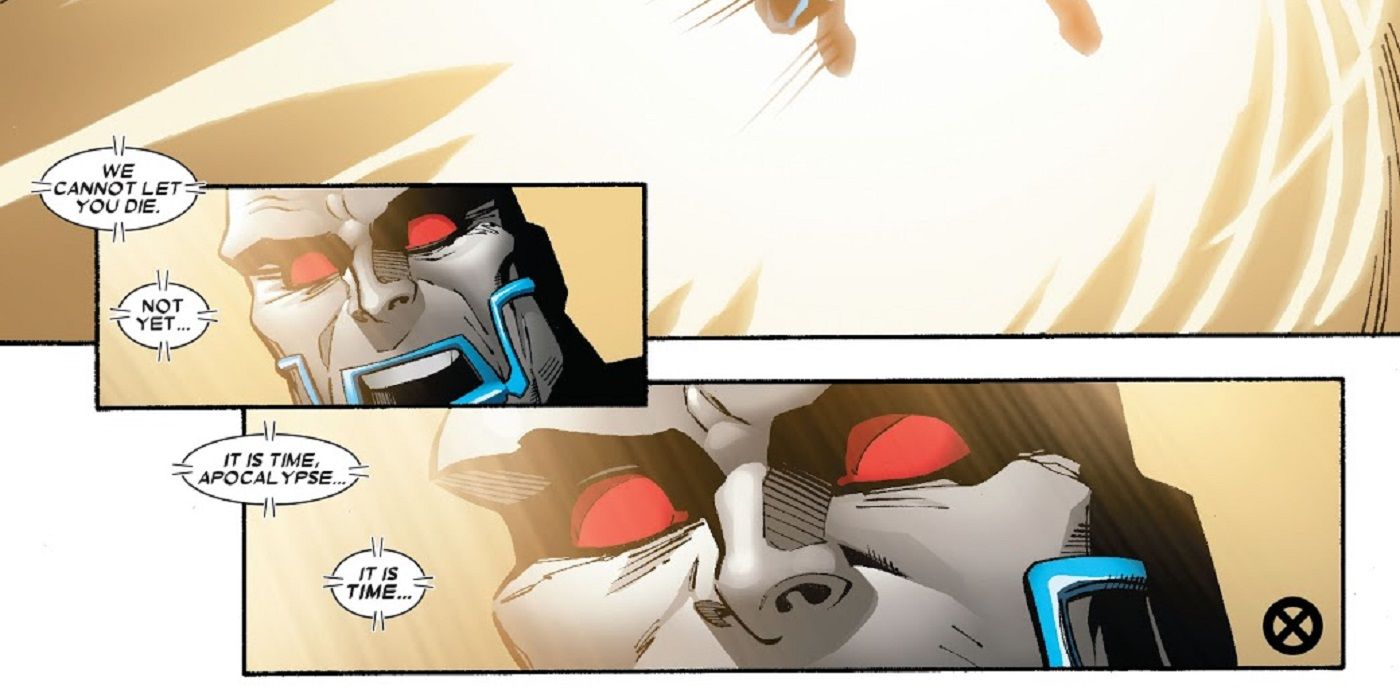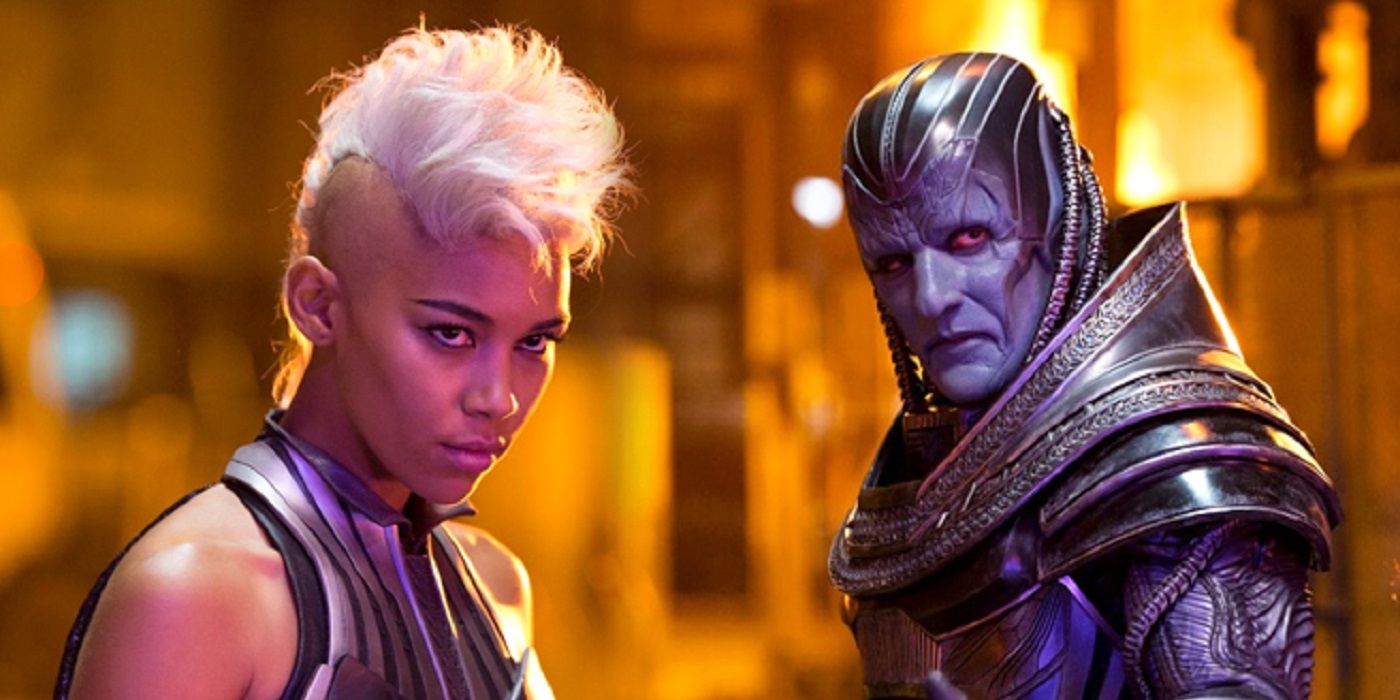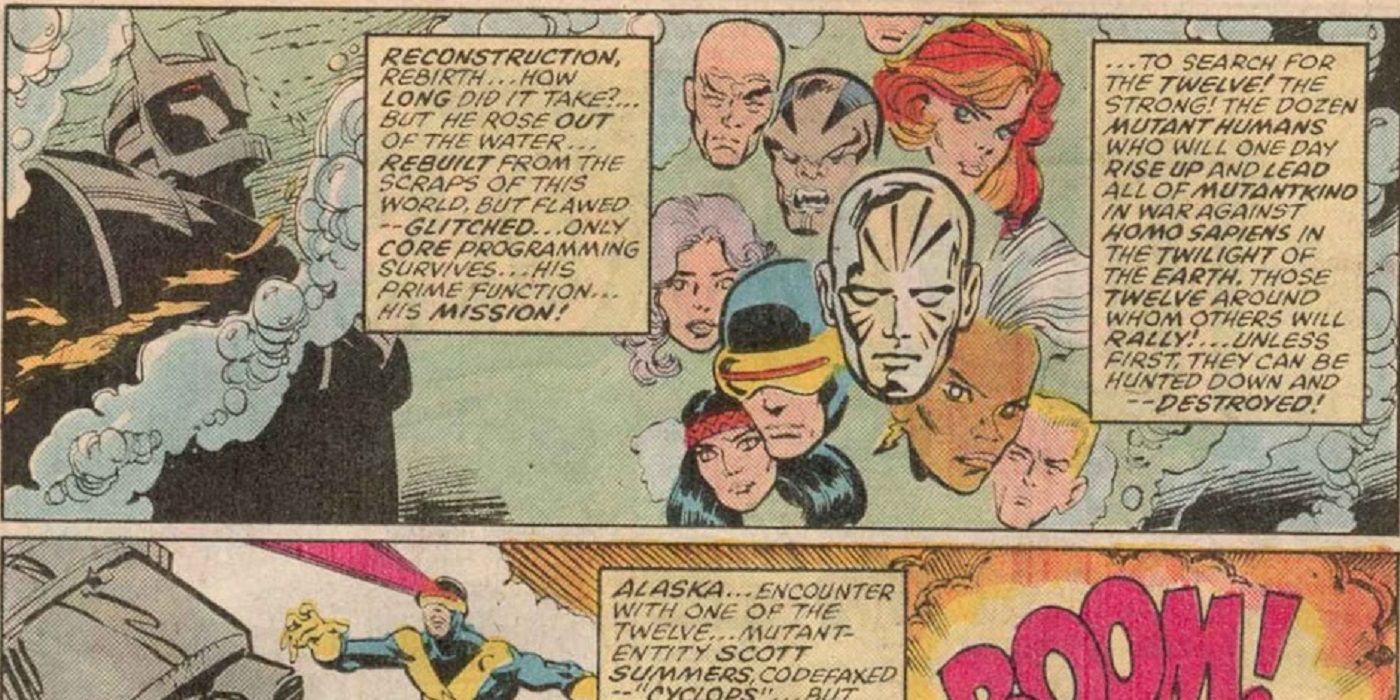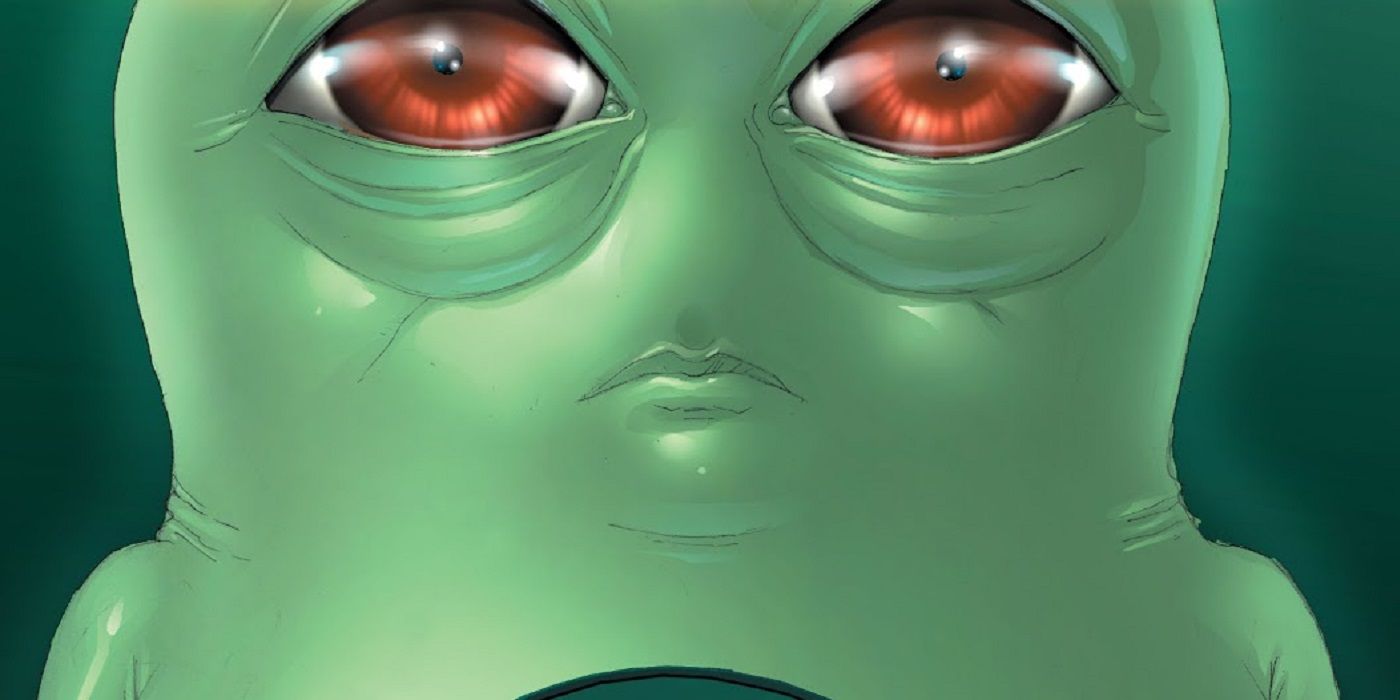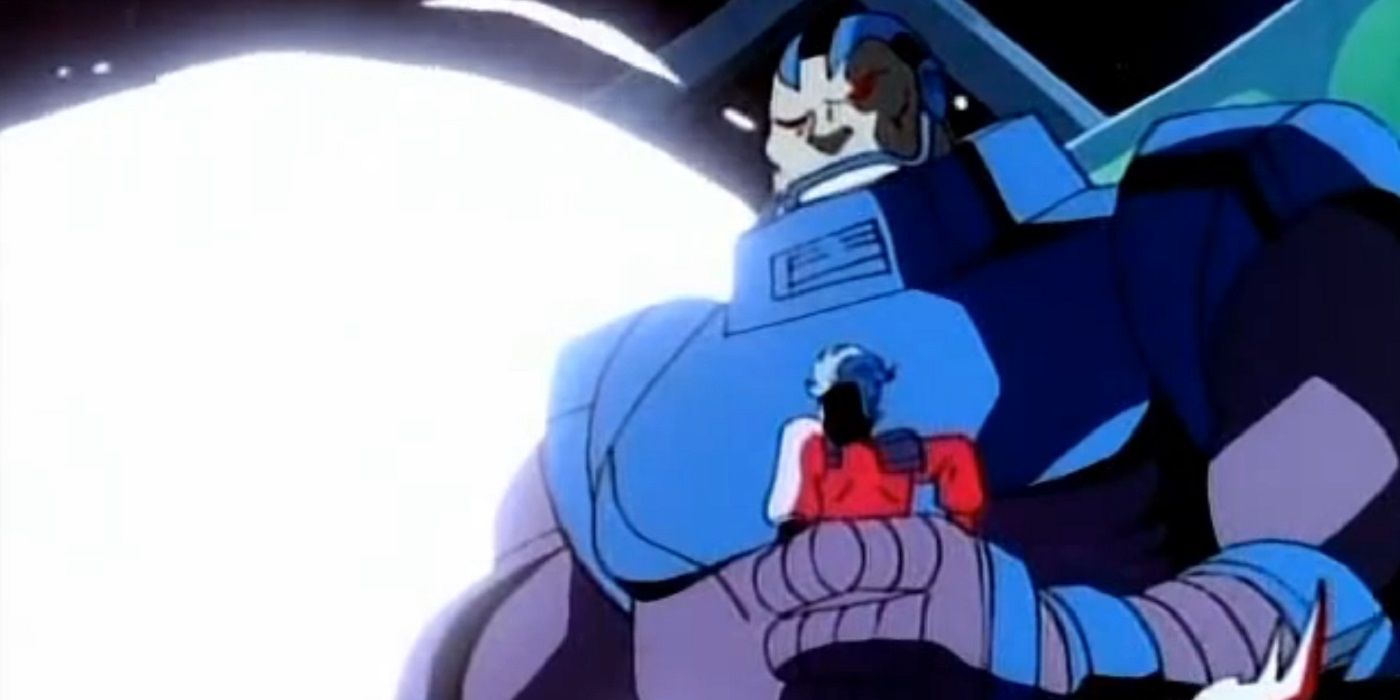In the hierarchy of X-Men villains, it really is a case where Magneto gets the first few tiers all to himself and then eventually you get to villains like Mister Sinister and En Sabah Nur, the villain known as Apocalypse. He started out as an X-Factor villain, with a stunning design... although no one is quite sure who came up with in the first place. The editor of the comic, Bob Harras, credited then-incoming artist Walter Simonson, but Simonson says that then-outgoing X-Factor artist, Jackson Guice, is the one who designed Apocalypse. In any event, when X-Factor merged back with the X-Men to form a giant-sized team of X-Men, Apocalypse moved his sights to the X-Men. He has been a recurring villain ever since, especially during his most famous epic, the time-traveling storyline "Age of Apocalypse," where time travel led to Apocalypse taking over the world in an altered reality.
However, for such a prominent villain, there sure are a lot of things about Apocalypse that do not exactly make a whole lot of sense. This is true not just in the comics, but also in his appearances on the X-Men Animated Series and in his film appearance in X-Men: Apocalypse. Here, we will spotlight 20 of the things about the X-Men villain that still puzzle us, three decades after he made his debut.
20 HE SURE DOES LOSE A LOT, HUH?
Naturally speaking, you cannot expect super villains to always exhibit admirable character traits. Still, Apocalypse remains an extreme case of "do as I say, not as I do," especially when it comes to his whole "survival of the fittest" mantra, which he professes to follow throughout his life. We mention that because, otherwise, Apocalypse could not possibly claim to hold true to that belief.
The simply fact is, he loses... constantly.
In fact, other than an alternate reality caused by Xavier being killed by his own son in the past, it does not seem as though Apocalypse has been able to win any of his battles with the X-Men. Even in "The Age of Apocalypse," he is ultimately defeated before reality is set right via Bishop going back in time and preventing Legion from killing Xavier in the past. Therefore, it is beyond hypocritical for him to continue to harp on his stance of "the survival of the fittest" without at least noting that he sure does not seem to be the fittest villain around. Even Count Nefaria actually managed to kill Thunderbird when he first fought the X-Men. What's Apocalypse ever done, besides give powers to Archangel?
19 WAIT, HE'S IN ARMOR?
In 1994, following the marriage of Cyclops and Jean Grey, the two were transported on their honeymoon into the future in the miniseries, The Adventures of Cyclops and Phoenix, where they landed in bodies attuned to their particular bio-rhythms (named Slymm and Redd, of course, in honor of Cyclops and Jean Grey's nicknames). They were brought to the future by an older version of Rachel Summers, their daughter from an alternate future. She brought them to the future so that they could raise young Nate Summers. They remained in the future until Nate was a young man and then returned to their bodies in their present as if no time had passed.
During this time, we learned that Nate's clone, named Stryfe, was set to become Apocalypse's next host. The thing is, up until this point, Apocalypse had never given any indication that he required hosts! We had seen Apocalypse when he was a young man and he was blue and had those weird giant wraparound lips of his; and yet, now it is revealed that he was somehow in armor? It makes no sense! It clearly was not an armor! It was plainly just En Sabah Nur's body... until they inexplicably changed things and now he used host bodies.
18 WAS HE BEHIND WEAPON-X?
It is likely unfair to point out things that were intended to happen but didn't happen for whatever reason as examples of things that do not make sense about Apocalypse; but hey, however we get there, the end result is something that did not make sense. When Barry Windsor-Smith sat down to write "Weapon X," finally telling the story of how Wolverine received his adamantium skeleton, he did not want to step on the toes of Chris Claremont, his friend and colleague. So, he asked Claremont who he had intended on being behind Wolverine's adamantium. Claremont said "Apocalypse." Thus, Windsor-Smith added some scenes where the head of the Weapon X project is talking to a mysterious being on the phone.
The intent being that it was Apocalypse behind Wolverine's adamantium claws!
This would be why Wolverine recognized Archangel, who had been given metal weapons by Apocalypse, just like how Claremont believed Wolverine had received his adamantium from Apocalypse. However, Claremont never got around to actually writing that story and then later writers went in a different direction, so now the whole "Hey, what's that I smell?" scene between Wolverine and Archangel makes no sense.
17 WOULD WAKING UP EARLY REALLY MATTER THAT MUCH?
The whole concept behind "Age of Apocalypse" is that the fight between Legion, Xavier and Magneto (plus the time-displaced X-Men there to help stop Legion from killing Magneto -- Storm, Psylocke, Bishop and Iceman) woke Apocalypse up from his slumber 10 years before he was originally planning on waking up. Therefore, he was able to conquer the Earth before the age of superheroes actually got a chance to get started, which resulted in "The Age of Apocalypse."
The problem with that is twofold. First off, what time, exactly, was his wake up call set to go off? He talks about how he was waiting for the genetic tree to result in mutants being around, but, as we established by the presence of Xavier and Magneto (and countless retcons since), mutants were already around. So why didn't Apocalypse's alarm go off early anyways? Secondly, when Apocalypse's slumber was interrupted in his original timeline, what had really changed all that much that he was not able to just conquer Earth? Ant-Man and the Wasp were now active? His actions upon his early awakening did not follow the pattern that he had established from his actual awakening. There was not a good explanation for why his tactics changed.
16 WAS HE EVER PLANNING ON FIGHTING THE X-MEN?
Apocalypse's tactics when he did wake from his slumber were not particularly logical. Right off the bat, one confusing thing emerges is that, if Apocalypse was intended to be behind Wolverine's adamantium, he would have had to have been awake already pretty darn early, no? Secondly, when he faced off against X-Factor during "Fall of the Mutants," he sure did not sound like a guy who had just recently woken up when the X-Men first showed up.
Finally, his actions once the X-Men did show up and set off his release from his slumber sure seem to be confusing, in the sense that he is actively working against the X-Men behind the scenes and yet never actually encounters them until long after he has become a recurring foe for a whole other team in X-Factor. Part of this is just retcons, but revealing that Apocalypse was behind Moses Magnum gaining superpowers before he fought the X-Men and that Apocalypse was behind the Living Pharaoh gaining powers (before he, too, fought the X-Men) makes it very strange that Apocalypse then did not fight the X-Men himself. Instead, he skips them by to go to their forebears in X-Factor, which sure sounds like the opposite of Apocalypse's typical way of thinking.
15 WHAT DID THE CELESTIALS WANT FROM APOCALYPSE?
Already, Apocalypse's history with the Celestials did not really make a whole lot of sense. When he fought against X-Factor in the late 1980s and early 1990s, he had access to a ship that was from the Celestials. After defeating Apocalypse during "Fall of the Mutants," this ship later became the home of X-Factor, when it was dubbed, appropriately enough, "Ship." Hey, not every X-codename of the era was convoluted! In an early issue of X-Force, we saw a flashback to when En Sabah Nur discovered some lost Celestial technology that he used to become Apocalypse. However, a couple of years later, in a miniseries about Apocalypse's rise to power, we then saw him discover the Celestial technology at a much younger age.
So, for years, that was the hook: Apocalypse already had powerful mutant abilities, but combined with stolen Celestial technology, he became a powerhouse.
However, years later, we instead learned that the Celestials had actually visited Apocalypse when he was younger and made a deal with him. They would give him their technology to make himself powerful and in return they would....well, it was never really explained. He would just sort of owe them something? It did not really make much sense.
14 WHY DID APOCALYPSE GIVE UP AGAINST THE X-MEN?
The X-Men Animated Series came about at a time when Apocalypse was really in a perfect position to be marketed to the masses. He had been part of the initial wave of ToyBiz Marvel toys and his distinct look made for a visually appealing villain for the animated series, so they used him a lot on the show. However, its use of the character was routinely bizarre. The main thing was that he just didn't really do anything! Well, he certainly had lots of crazy plots and schemes, but we meant that when it came down to actual fights with the X-Men, he somehow always seemed to shrink from the fight, even when it was pretty evident that he was much stronger than everyone else.
The first time this was made evident was in the two-part episode in Season 1 where Apocalypse uses Mystique to trick mutants into agreeing to undergo a "cure" for their mutant powers. Of course, it would instead transform them into Apocalypse's Horsemen. One of the mutants who falls for the scheme is the former X-Man known as Angel. He is transformed into Archangel. The Horsemen then fight the X-Men, with Apocalypse right behind them. Archangel manages to break free of Apocalypse's control and helps the X-Men defeat the Horsemen. Then Apocalypse just... runs away! He had just easily blasted Rogue away but then he decided that, what, it would be too easy to defeat them now?
13 WHY DID HIS HORSEMEN FOLLOW HIM?
In X-Men: Apocalypse, Apocalypse awakens and quickly puts together a team of Horsemen, like he is best known for in the comics (where he transforms mutants into his Horsemen servants). Here's the thing in the film, though: while there is a lot of time spent on Apocalypse wooing Magneto into joining him as his main Horseman, there is not a whole lot of time put into why the other three members of the team join up with him. Angel, at least, got new fancy wings, but why, exactly, did Psylocke join up with Apocalypse? It is just treated as if it made sense when it really did not.
Later, director Bryan Singer explained that Apocalypse apparently had some sort of secret persuasion powers.
"He has various abilities and powers, one of them.... is the power of persuasion, and part of why that's necessary is he needs other followers to be his Horsemen, and some of them would be hard to persuade - Magneto, Erik being the hardest. It's interesting, what's a little bit, hopefully, complex in the movie, or even ambiguous, is how much he's persuading his followers with a superhuman ability or just he's like any cult leader who is really good at convincing people to follow him, so we don't really ever make that explicit. It's not like he's putting people under a spell, but he is superhumanly persuasive." That sure sounds like he just didn't want Storm and Psylocke to look like jerks for following him.
12 THE ALLIANCE OF EVIL?
The original writer on X-Factor was Bob Layton, and one of the things he was going to do with the series was try to get it out of the sort of "mutant corner" of the Marvel Universe, where the X-related characters did not get involved in the rest of the Marvel Universe all that often. Layton wanted to tie it in more directly with the rest of the universe while, of course, keeping the mutant rights issue at the forefront of the series. X-Factor formed as a team of "mutant hunters," who secretly train the mutants that they "hunt down" in public. As a tie-in to that idea, the mystery villain that was behind the Alliance of Evil in the early issues of the series was going to be revealed to be a revamped version of the old Daredevil villain, the Owl.
Layton was then taken off of the series and new series writer Louise Simonson instead had the big bad guy revealed to be Apocalypse. That worked better for the whole mutant connection, but the drawback of revealing that Apocalypse is secretly behind the Alliance of Evil is that Apocalypse would be, you know, behind the Alliance of Evil! The Alliance of Evil was one of the most forgettable supervillain teams around, and this was the team that Apocalypse put together when he decided to reveal himself to the world?
11 DID APOCALYPSE... KILL CABLE?
In Cable's first miniseries, the set-up behind the story is that Cable has to try to beat Stryfe to various special relics and weapons, while also dealing with the whole revelation that Stryfe looks just like him (this was back when Cable did not know the truth of his heritage). Stryfe ends up walking away with most of the relics that he wanted, including a special knife that we only saw briefly, but the ornateness of which stuck out in the miniseries. Later, in the "X-Cutioner's Song" crossover event, we got to see the knife in great detail when Stryfe uses it to seemingly stab Apocalypse to death.
So, at some point in history, Apocalypse stabs Cable to death? We guess?
As he is seemingly fatally wounded, Apocalypse is shocked to see the knife again, as he recalled it being what he had used to kill Cable... apparently? It might be Stryfe, but Apocalypse sure seems to be referring to Cable, who looks just like Stryfe. So, at some point in history, Apocalypse stabs Cable to death? We guess? Even if that is true, then it still doesn't explain the point of Stryfe seeking out this special knife just to stab Apocalypse once, and then let him get away and survive the attack. Tellingly, the knife is never mentioned again.
10 WHAT WAS THE POINT OF THE EXTERNALS?
In a shocking turn of events in an early issue of X-Force, Cannonball is seemingly murdered in a battle against the new Brotherhood of Evil Mutants, during which he got himself killed in a battle against a villain team led by Toad. That does not say a whole lot about Cannonball's skill levels, first of all. However, the real shock is when Cannonball turns out to have somehow survived being seemingly stabbed to death! How is that? Well, as it turns out, Cannonball is an "External," a special group of immortal mutants.
The 1990s was the era where plot danglers were taken to a whole new level.
Cable actually hooked up with the New Mutants specifically to meet Cannonball because he knows that the Externals are key to his defeating Apocalypse. However, they don't actually do anything with Apocalypse. The Externals just sort of fade away, with most of them killed by Selene in a big, "Oops, we guess that this isn't really a thing!" storyline. So the whole reason Cable came to the past to meet the New Mutants was to get an External to help him fight Apocalypse and that just didn't mean anything? That sadly sounds fairly typical for most 1990s X-related storylines.
9 THE TIME LOOP THAT WASN'T?
The X-Men Animated Series really loved to use Apocalypse, and while his voice actor -- the late, great John Colicos -- did an amazing job, Apocalypse continued to not really acquit himself well on the show, despite the fact that it blatantly establishes that he could essentially kill the X-Men any time he wants! In the two-parter, "Time Fugitives," the animated series tried to capture the insanely convoluted aspects of the comic book when it comes to time travel, as Apocalypse creates a virus in the present that he figures will force a human/mutant war. Bishop shows up from his future to try to stop the virus from existing, but then Cable shows up from his future to stop Bishop, because the virus needs to exist or else mutants will eventually become unstable and die.
The end of the first episode ends with Apocalypse increasing in size and then just flat out destroying the X-Men. Just literally annihilating them. Then, of course, there's time travel involved so the X-Men are saved when the end of the first episode is replayed. Not for nothing, but it also served to save the show some money, as it seriously just replayed scenes from the first episode. This time, though, Cable comes up with a solution to the problem (Spoiler: he had Wolverine beat the virus). However, Apocalypse, put into the same position, doesn't annihilate them this time... for no reason!
8 HOW DID HE SURVIVE CYCLOPS' BLAST?
In the final storyline in X-Factor before the "Muir Isle Saga," X-Factor heads to the moon to take on Apocalypse, who apparently has a place on the moon, as well, for whatever reason. The team followed him there, along with the assistance of the Inhumans, who were living on the moon at the time, as well. In a move that, in and of itself, seems to be a bit inexplicable, Apocalypse infects Cyclops' son with a techno-organic virus that seems like it will kill the toddler.
It really seems like Apocalypse did it for no other reason than just to be a jerk.
Cyclops ultimately has to agree to send his son into the future where he can be possibly cured. Also, in an odd bit, there is no reason given as to why Cyclops can't go to the future with his son. He just sort of assumes that it isn't possible. As it turned out, of course, his son later became Cable. In any event, Cyclops is so angry that he cuts loose and flat out explodes Apocalypse. How in the world did he survive that? The panels, amusingly, just see Cyclops note, "I'm sure he'll survive. Villains always do." However, we were never given an explanation as to how he survived!
7 HOW DID HE NOT SURVIVE "THE BLOOD OF APOCALYPSE"?
In literally the antithesis of the "Muir Island Saga," storyline, years later, Apocalypse would show up at the home of the X-Men in "Blood of Apocalypse," where he promised to restore the mutant abilities of any mutant who had lost their powers in the then-recent Decimation following House of M, wherein the Scarlet Witch had used her reality-altering powers to say "No more mutants," which wiped out most of the mutant population from the planet in one fell swoop. The X-Men, at the time, were essentially trapped in their mansion (with giant Sentinels "protecting" them) and to some mutants, Apocalypse's offer sounded good. Even Gambit bizarrely took him up on the deal, even though he did not lose his powers in Decimation!
At the end of the story, the X-Men had defeated Apocalypse in his flying Sphinx. Okay, you have to give Apocalypse credit for having his base being a giant flying Sphinx. The guy certainly knows how to travel in style. First a Celestial ship and then a flying Sphinx. Thereafter, Apocalypse just decided to kill himself. However, the Celestials then prevented him from dying. Remember that -- they wouldn't let him die. So the next story involving Apocalypse? A cult that followed him was raising a clone of him following his death in "Blood of Apocalypse"!
6 WHY DID HE EVEN WANT ANGEL AS A HORSEMAN?
In X-Men Apocalypse, Apocalypse awakens in the present day and decides to put together his Four Horsemen. We've already established that it was not particularly well explained as to why all of the mutants agreed to work with Apocalypse, but perhaps even more inexplicable is why he chose these particular heroes. He runs into Storm by accident, but she's plainly very powerful, so it makes sense that he would want to work with her, but after getting Caliban into the mix, who essentially has the ability to find any mutant in the world, the rest of the team is rounded out by... Psylocke and Angel?
Psylocke at least makes a little sense, but Angel really doesn't fit in the conversation at all.
The only reason he would be chosen was because of his connection to Apocalypse in the comic books, but that was under a completely different context. In the context of the film, picking Angel for his Horsemen did not make sense. Think of how many other mutants Caliban could have found for Apocalypse, and they decided to just go with the flying guy who was nearby?
5 WHAT DID HE DO WITH THE TV?
As noted, in X-Men Apocalypse, Apocalypse awakens in 1983 and soon befriends Storm, who he recruits to his cause. When he goes to visit the place where Storm lives, he touches her television set and suddenly gains the ability to know all modern languages and catch up on all current events. Now, television is certainly quite educational, but it doesn't make sense that Apocalypse would be able to simply touch a TV set and gain all of those abilities, even if you believe that Apocalypse has a sort of Cypher-like control over machinery.
Then again, Apocalypse's powers have rarely made sense.
They often seem to be whatever power he happens to need in that moment. Still, even with that in mind, it read as a far too quick way of getting Apocalypse up to speed for the sake of the film's story. Then again, since he apparently has his Celestial technology in this film, as well, then perhaps there is some sort of super-scientific explanation for his ability to soak up all of that information.
4 THE TWELVE MAKE NO SENSE
One of the all-time convoluted X-related plotlines was the story of the mythical "Twelve," a dozen powerful mutants who were, according to the Master Mold, "mutant humans who will one day rise up and lead all of mutantkind in war against homo sapiens in the twilight of earth." The recurring members of the Twelve over the years were Franklin Richards and Apocalypse. Eventually, Cable was specifically tasked with putting the Twelve together to help take down Apocalypse.
As it turned out, Apocalypse somehow faked the whole thing. That, in and of itself, doesn't make sense, as the Master Mold gained access to the information from a time traveler who presumably would have had better information than, "Oh, yeah, that was some trick Apocalypse pulled back in the 1990s, wasn't it?" On top of that, Cable learns that he is supposed to gather the Twelve to stop Apocalypse and he goes out and... doesn't do that at all. Instead, he becomes the first member of the Twelve to be captured by Apocalypse. Talk about falling down on the job! For years, obsessive X-Men fans would debate who should be the members of the Twelve and then it all turns out to be an Apocalypse hoax? That was way too weird.
3 HE DOES KNOW WHAT MAGNETO'S POWERS ARE, RIGHT?
As noted before, the big hook for "The Age of Apocalypse" is that Legion accidentally kills his own father, Charles Xavier while trying to kill Magneto instead. Magneto is inspired by the dying wishes of his best friend to take on Xavier's cause and form the X-Men on his own, but this is at the same time that Apocalypse is quickly coming to power in the world and conquering everything. Magneto and his X-Men are the only thing standing in the way of Apocalypse taking over the world.
Meanwhile, Apocalypse always has a force field around his home so that the humans on Earth can't just drop nukes on him.
In the storyline of "Age of Apocalypse," however, the force field is destroyed and the humans do, indeed, decide to just nuke the mutants. Before that point, Apocalypse decides to have a one-on-one matchup with Magneto, the head of the X-Men and Magneto quickly reminds him that Apocalypse's armor is filled with metal. Magneto seriously tears him into two pieces with his powers! For a guy obsessed with being the survivor of the fittest, he should have probably known not to mess with a guy who can control the metal in his armor!
2 WHO THE HECK IS DAAP?
In the dramatically revamped X-Force in 2001, one of the new members of the team was Doop, a mysterious green shapeless floating being who spoke in his own unique language. Doop was the cameraman for the team and by the end of the series (after the book ended and was rebooted as X-Statix), is the only member of the team to survive their final storyline. Doop then continued to appear in other stories, mostly written by Milligan, including a classic tale where a private investigator falls in love with Doop while he is hired to follow a rich man's cheating wife.
The whole series involved the heroes of the book routinely dying in battle.
When Milligan began writing the X-Men, he quickly brought in a new character that looked like Doop, a female alien known as Daap. The weird part, though, is that Daap brings Polaris and Leper Queen to the attention of Apocalypse, who helps turn Polaris into one of his Four Horsemen. The thing is that we never learn what Daap's deal is. Did Daap seriously just routinely turn over mutants to Apocalypse to be transformed into horsemen? Or are there hidden depths to Daap?
1 POWER OF TIME AND SPACE AND HE STILL LOSES?!
"Beyond Good and Evil" was a four-party storyline in the X-Men Animated Series that aired in the fourth season. When the episodes were written, they were intended to be the conclusion of the series; as a result, the story was packed to the brim with every major X-Men character and villain. At the heart of the story, though, is Apocalypse, who traveled to the present (his past) from his future after a fight with Cable (where Cable lost his time-traveling computer to Apocalypse). Apocalypse ends up in control of time and space itself.
He then begins collecting telepathic mutants (and other characters, including Oracle of the Shi'Ar Imperial Guard) so that he can actually destroy the universe itself so that he can start things over, with Apocalypse in charge. The X-Men have to team up with Magneto to defeat this shocking plan, but what is also shocking is that Apocalypse has taken over control over time and space... and still loses! It is almost like this is all a little game to him and he hates it when he wins too easily, so he comes up with ways to let people defeat him. Otherwise, this guy just loses an incredible amount for a villain known for the "Survival of the fittest."

